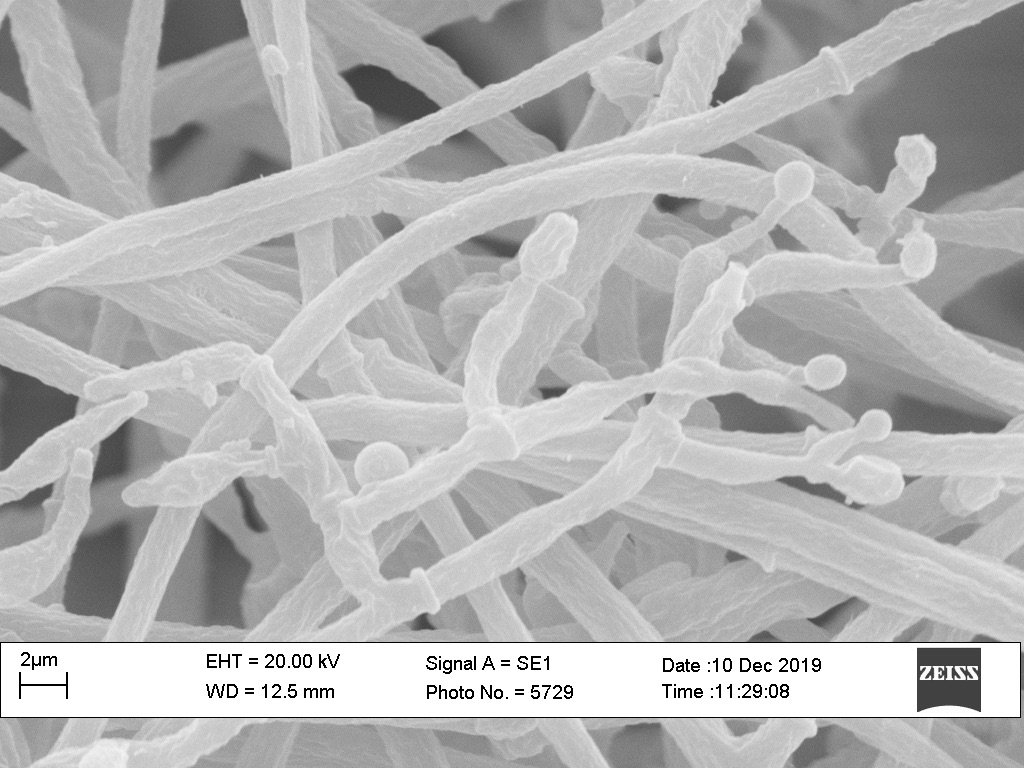A soil fungus affects insect-plant interactions by manipulating the insect gut microbiota
By Francesco Pennacchio and Matteo Montagna, University of Naples Federico II, and Morena Casartelli, University of Milan
Figure 1. Trichoderma afroharzianum SEM micrograph.
Together with other Italian colleagues, we recently published a scientific paper in PNAS (https://www.pnas.org/doi/abs/10.1073/pnas.2216922120) demonstrating that the resistance of tomato plants to pest insects is driven by a symbiotic soil fungus that alters the insect’s gut microbiota. This beneficial fungus, Trichoderma afroharzianum (Figure 1), lives in the plant root system and helps protect the plant from pathogenic fungi. Due to its well-known biological control mechanism, Trichoderma is widely used as a biocontrol agent in agriculture.
Figure 2. Spodoptera littoralis larva.
We investigated how this beneficial soil fungus affects the survival of larvae of the moth Spodoptera littorals (Figure 2), a pest insect of major agricultural importance. Larvae fed on leaves from tomato plants colonized by T. afroharzianum (treated larvae) exhibited significantly greater mortality compared to larvae fed on leaves from Trichoderma-free plants (control larvae). We found that treated larvae showed an alteration in the composition and functionality of the gut microbiota compared to control larvae. Analysis of the metabolic activity of the microbiota revealed that bacterial pathways that were able to nutritionally support the larvae, including those associated with the biosynthesis of amino acids, were altered in treated larvae. Most of these activities were attributed to the Gram-positive bacterium Enterococcus casseliflavus, whose importance for larval fitness is well known. Interestingly, the oral administration of Enterococcus bacteria isolated from control larvae to those which fed on leaves from tomato plants colonized by Trichoderma, rescued the negative effects, thus restoring larvae survival.
This study reveals a below and above-ground microbial network that is able to affect plant-insect interactions, with a possible impact on the stability and evolution of natural communities. These interactions should be carefully considered for the development of sound strategies for the sustainable management of agroecosystems. Further, they should also be taken into account for in-depth assessments of the ecological impact of biocontrol agents, not only on target and non-target organisms, but also on their associated microbiota.
Figure 3. Schematic representation of the interactions among the plant Solanum lycopersicum, the fungus Trichoderma afroharzianum strain T22, and the phytophagous insect Spodoptera littoralis and its gut microbiome. The colonization of S. lycopersicum roots by the fungus T. afroharzianum strain T22 (1) systemically conditions the plant (2), generating a dysbiosis of the gut microbiome in S. littoralis larvae feeding on tomato leaves with neither structural damages to the midgut epithelium and peritrophic matrix nor alterations in the digestive capacity of the insect. This dysbiosis, among others, affects symbiotic bacteria of the genus Enterococcus and the functional capability of Enterococcus casseliflavus to nutritionally support the insect host with sugars and amino acids (3), with a consequent negative impact on S. littoralis development and survival (4). E: E. casseliflavus bacterial cells; M: microvilli; PM: peritrophic matrix; orange, green, and light blue shapes: insect digestive enzymes.



